Analysis of Nestle's International Recruitment and Training Project
VerifiedAdded on 2023/02/02
|23
|3607
|50
Report
AI Summary
This report examines Nestle's international business project, focusing on the improvement of recruitment, selection, and training procedures to meet global requirements. The report includes an introduction to globalization and its impact on organizations, particularly Nestle. It outlines the project's aims, objectives, and a detailed project management plan, including cost, scope, time, quality, communication, risk, and resource management. The report also presents a work breakdown structure and Gantt chart for project timelines. Furthermore, it details the research methodology, employing a quantitative approach with questionnaires, sampling, and data analysis to assess employee knowledge and opinions on globalization and its effects on Nestle's operations. The findings, presented in charts and interpretations, offer insights into the importance of adapting HR practices for international success. Finally, the report concludes with recommendations for improving Nestle's recruitment, selection, and training strategies to enhance its global competitiveness.

Managing
Successful Business
Project
Successful Business
Project
Paraphrase This Document
Need a fresh take? Get an instant paraphrase of this document with our AI Paraphraser


INTRODUCTION
In today's era globalisation is a process that determines integrating and communicating
among people, government and companies at wider context. Globalisation in an organisation is
define as expansion of business in order to attain enhancement, profitability and productivity
with high customer base in order to develop at international business (Beamish,
2013).Additionally, main aim of a particular organisation is to develop more towards
international in order to attain market share in competitive edge. In this report organisation
chosen is Nestlé, a Swiss transactional food and drink company in world wide. They are dealing
in variety of products such as baby food, coffee. Dairy products and ice cream etc.. Moreover,
the aim of this report is to evaluate and analysis objectives for a case study of Nestle that is
improving requirement, selection and training if their employees to meet international
requirement. Furthermore, collecting information related to research and data with appropriate
recommendation, findings and conclusion.
TASK 1
P1 Project aims and objectives
Aim: To identify the importance of creating changes in recruitment, selection and
training procedures to meet international requirement.
Objectives:
To understand the basic concept of international way of recruiting, selecting and training.
To identify ways by which advantages at global level can be gained by Nestle. To evaluate benefits and drawbacks which are related with recruitment, selection &
training functions of Nestle.
Background of the study
Now these days, context internationalization is structure which has been adopted by
various organisation in expanding their business in international marketplace. This process is
adopted so that an organisation can sell their product and services in competitive marketplace. In
this way business can increase their productivity, profitability, customer's loyalty in order to
In today's era globalisation is a process that determines integrating and communicating
among people, government and companies at wider context. Globalisation in an organisation is
define as expansion of business in order to attain enhancement, profitability and productivity
with high customer base in order to develop at international business (Beamish,
2013).Additionally, main aim of a particular organisation is to develop more towards
international in order to attain market share in competitive edge. In this report organisation
chosen is Nestlé, a Swiss transactional food and drink company in world wide. They are dealing
in variety of products such as baby food, coffee. Dairy products and ice cream etc.. Moreover,
the aim of this report is to evaluate and analysis objectives for a case study of Nestle that is
improving requirement, selection and training if their employees to meet international
requirement. Furthermore, collecting information related to research and data with appropriate
recommendation, findings and conclusion.
TASK 1
P1 Project aims and objectives
Aim: To identify the importance of creating changes in recruitment, selection and
training procedures to meet international requirement.
Objectives:
To understand the basic concept of international way of recruiting, selecting and training.
To identify ways by which advantages at global level can be gained by Nestle. To evaluate benefits and drawbacks which are related with recruitment, selection &
training functions of Nestle.
Background of the study
Now these days, context internationalization is structure which has been adopted by
various organisation in expanding their business in international marketplace. This process is
adopted so that an organisation can sell their product and services in competitive marketplace. In
this way business can increase their productivity, profitability, customer's loyalty in order to
⊘ This is a preview!⊘
Do you want full access?
Subscribe today to unlock all pages.

Trusted by 1+ million students worldwide
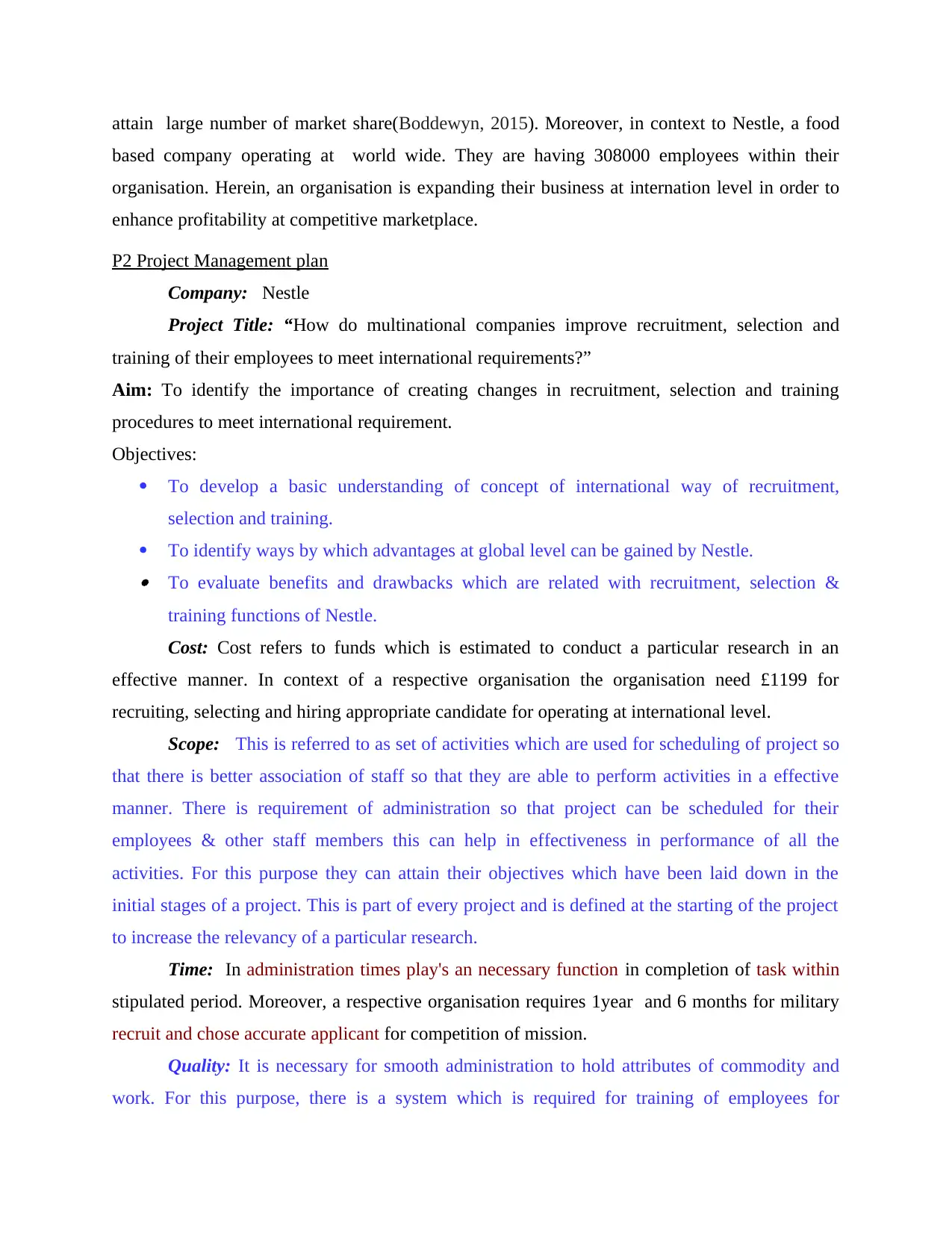
attain large number of market share(Boddewyn, 2015). Moreover, in context to Nestle, a food
based company operating at world wide. They are having 308000 employees within their
organisation. Herein, an organisation is expanding their business at internation level in order to
enhance profitability at competitive marketplace.
P2 Project Management plan
Company: Nestle
Project Title: “How do multinational companies improve recruitment, selection and
training of their employees to meet international requirements?”
Aim: To identify the importance of creating changes in recruitment, selection and training
procedures to meet international requirement.
Objectives:
To develop a basic understanding of concept of international way of recruitment,
selection and training.
To identify ways by which advantages at global level can be gained by Nestle. To evaluate benefits and drawbacks which are related with recruitment, selection &
training functions of Nestle.
Cost: Cost refers to funds which is estimated to conduct a particular research in an
effective manner. In context of a respective organisation the organisation need £1199 for
recruiting, selecting and hiring appropriate candidate for operating at international level.
Scope: This is referred to as set of activities which are used for scheduling of project so
that there is better association of staff so that they are able to perform activities in a effective
manner. There is requirement of administration so that project can be scheduled for their
employees & other staff members this can help in effectiveness in performance of all the
activities. For this purpose they can attain their objectives which have been laid down in the
initial stages of a project. This is part of every project and is defined at the starting of the project
to increase the relevancy of a particular research.
Time: In administration times play's an necessary function in completion of task within
stipulated period. Moreover, a respective organisation requires 1year and 6 months for military
recruit and chose accurate applicant for competition of mission.
Quality: It is necessary for smooth administration to hold attributes of commodity and
work. For this purpose, there is a system which is required for training of employees for
based company operating at world wide. They are having 308000 employees within their
organisation. Herein, an organisation is expanding their business at internation level in order to
enhance profitability at competitive marketplace.
P2 Project Management plan
Company: Nestle
Project Title: “How do multinational companies improve recruitment, selection and
training of their employees to meet international requirements?”
Aim: To identify the importance of creating changes in recruitment, selection and training
procedures to meet international requirement.
Objectives:
To develop a basic understanding of concept of international way of recruitment,
selection and training.
To identify ways by which advantages at global level can be gained by Nestle. To evaluate benefits and drawbacks which are related with recruitment, selection &
training functions of Nestle.
Cost: Cost refers to funds which is estimated to conduct a particular research in an
effective manner. In context of a respective organisation the organisation need £1199 for
recruiting, selecting and hiring appropriate candidate for operating at international level.
Scope: This is referred to as set of activities which are used for scheduling of project so
that there is better association of staff so that they are able to perform activities in a effective
manner. There is requirement of administration so that project can be scheduled for their
employees & other staff members this can help in effectiveness in performance of all the
activities. For this purpose they can attain their objectives which have been laid down in the
initial stages of a project. This is part of every project and is defined at the starting of the project
to increase the relevancy of a particular research.
Time: In administration times play's an necessary function in completion of task within
stipulated period. Moreover, a respective organisation requires 1year and 6 months for military
recruit and chose accurate applicant for competition of mission.
Quality: It is necessary for smooth administration to hold attributes of commodity and
work. For this purpose, there is a system which is required for training of employees for
Paraphrase This Document
Need a fresh take? Get an instant paraphrase of this document with our AI Paraphraser

achievement of overall aims and objectives. This will also help in hiring and recruitment of
employees in accordance with requirements of organisation. This will lead to selection of best
applicants for a job profile. It is very necessary to ensure that a research is having very high
quality so that overall benefits of the whole research can be increaser.
Communication: In an organisation communication is necessary as it help to bring
proficiency in workplace (Brouthers, Nakos and Dimitratos, 2015).Herein, Nestle need to
communicate about their project to its employees and staff members by organising meetings and
session so that appropriate discussion can be done. This will also help in recruiting such as they
can post vacancy on job potables, social media and news paper.
Risk: Risk is associated within ever stage of an organisation. Eventually, if an
organisation fail to to have right candidates or else if employee or staff member fail to
understanding aims and objectives of an organisation. For such instance, an organisation will not
able to attain sustainability in international marketplace.
Resource: It is responsibilities of an organisation to maintain it resource so that plans and
process can be done according to estimated task. It main motive is that every resources can be
utilised in an effective manner. Moreover, they are offering grooming and improvement to their
workers so that work can be completed in attractive way.
P3 Producing work breakdown structure and Gantt Chart to provide time frames
Work Breakdown Structure: Word break down structure is a term which is related with
breaking down of work in smaller segments. This can help in ease in performance of work and
also is helpful in ensuring effectiveness in the whole task. This is mostly divided in three parts
and according to hierarchical disintegration of work. In some cases when the work performed is
more this can extend up to fourth and five stage also. Main objectives is to reduce the complexity
which arise while work is performed in a cumulative manner. Nestle can use this to determine
the overall disbursal if work which has to be done to achieve well defined objectives.
employees in accordance with requirements of organisation. This will lead to selection of best
applicants for a job profile. It is very necessary to ensure that a research is having very high
quality so that overall benefits of the whole research can be increaser.
Communication: In an organisation communication is necessary as it help to bring
proficiency in workplace (Brouthers, Nakos and Dimitratos, 2015).Herein, Nestle need to
communicate about their project to its employees and staff members by organising meetings and
session so that appropriate discussion can be done. This will also help in recruiting such as they
can post vacancy on job potables, social media and news paper.
Risk: Risk is associated within ever stage of an organisation. Eventually, if an
organisation fail to to have right candidates or else if employee or staff member fail to
understanding aims and objectives of an organisation. For such instance, an organisation will not
able to attain sustainability in international marketplace.
Resource: It is responsibilities of an organisation to maintain it resource so that plans and
process can be done according to estimated task. It main motive is that every resources can be
utilised in an effective manner. Moreover, they are offering grooming and improvement to their
workers so that work can be completed in attractive way.
P3 Producing work breakdown structure and Gantt Chart to provide time frames
Work Breakdown Structure: Word break down structure is a term which is related with
breaking down of work in smaller segments. This can help in ease in performance of work and
also is helpful in ensuring effectiveness in the whole task. This is mostly divided in three parts
and according to hierarchical disintegration of work. In some cases when the work performed is
more this can extend up to fourth and five stage also. Main objectives is to reduce the complexity
which arise while work is performed in a cumulative manner. Nestle can use this to determine
the overall disbursal if work which has to be done to achieve well defined objectives.
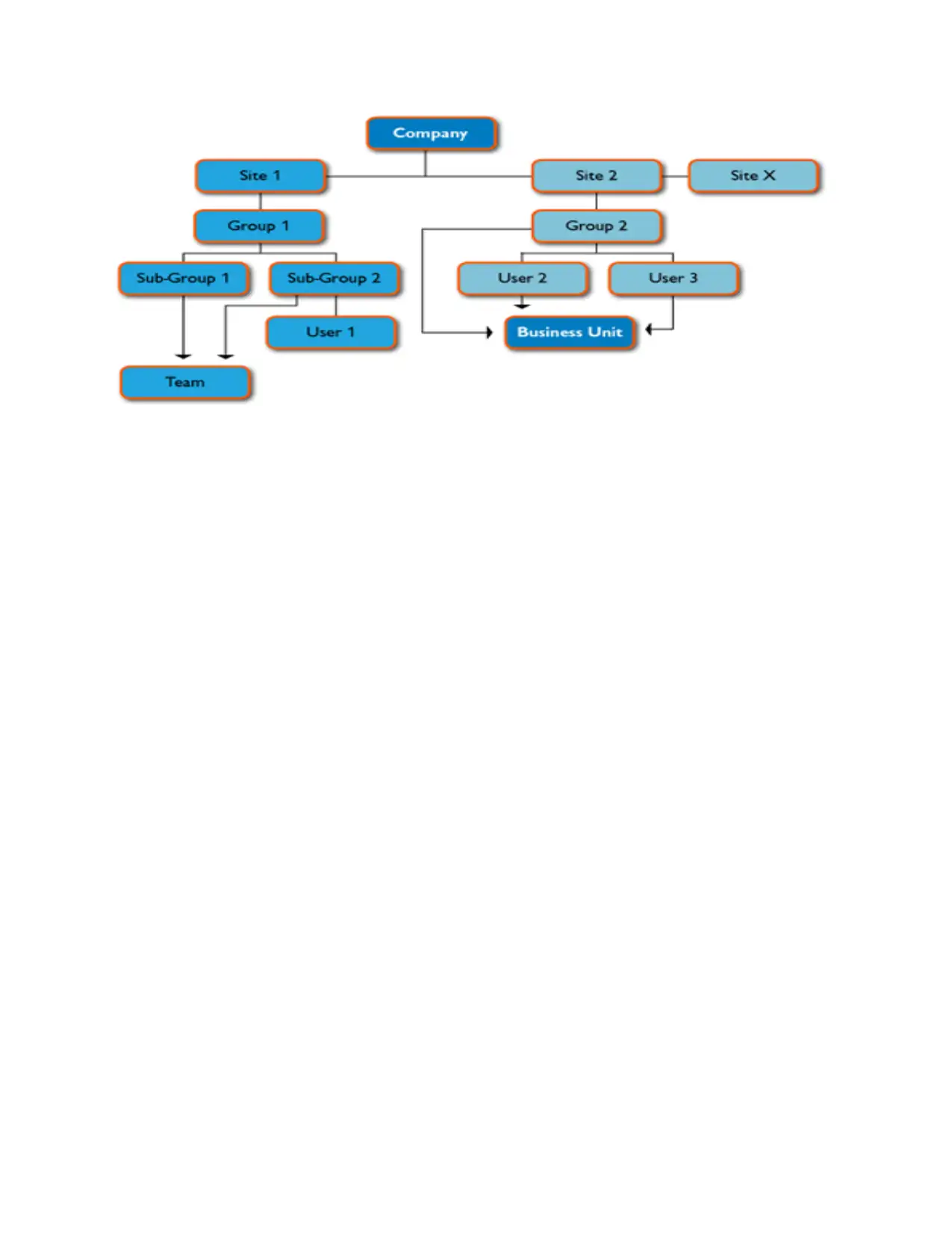
⊘ This is a preview!⊘
Do you want full access?
Subscribe today to unlock all pages.

Trusted by 1+ million students worldwide

Gantt Chart: Gantt chart is a term which is related to a vertical graph which is used for
elaborating a particular work which is used for elaboration of whole task which has to be done
and includes various activities such as assisting in planning, organizing and further finally
performing of the work. This is used for defining of the time frame for each activity of the
organisation. This is also used for determination of starting date of a project and ending time of
the project. The below discussed graph shows that at what time the activities will be started in
the organisation and the ned time at which activities will be ending. This will help in carrying of
the research in a more effective way as there is clear understanding which can be developed
between activities to be done and respective time frame.
7
elaborating a particular work which is used for elaboration of whole task which has to be done
and includes various activities such as assisting in planning, organizing and further finally
performing of the work. This is used for defining of the time frame for each activity of the
organisation. This is also used for determination of starting date of a project and ending time of
the project. The below discussed graph shows that at what time the activities will be started in
the organisation and the ned time at which activities will be ending. This will help in carrying of
the research in a more effective way as there is clear understanding which can be developed
between activities to be done and respective time frame.
7
Paraphrase This Document
Need a fresh take? Get an instant paraphrase of this document with our AI Paraphraser
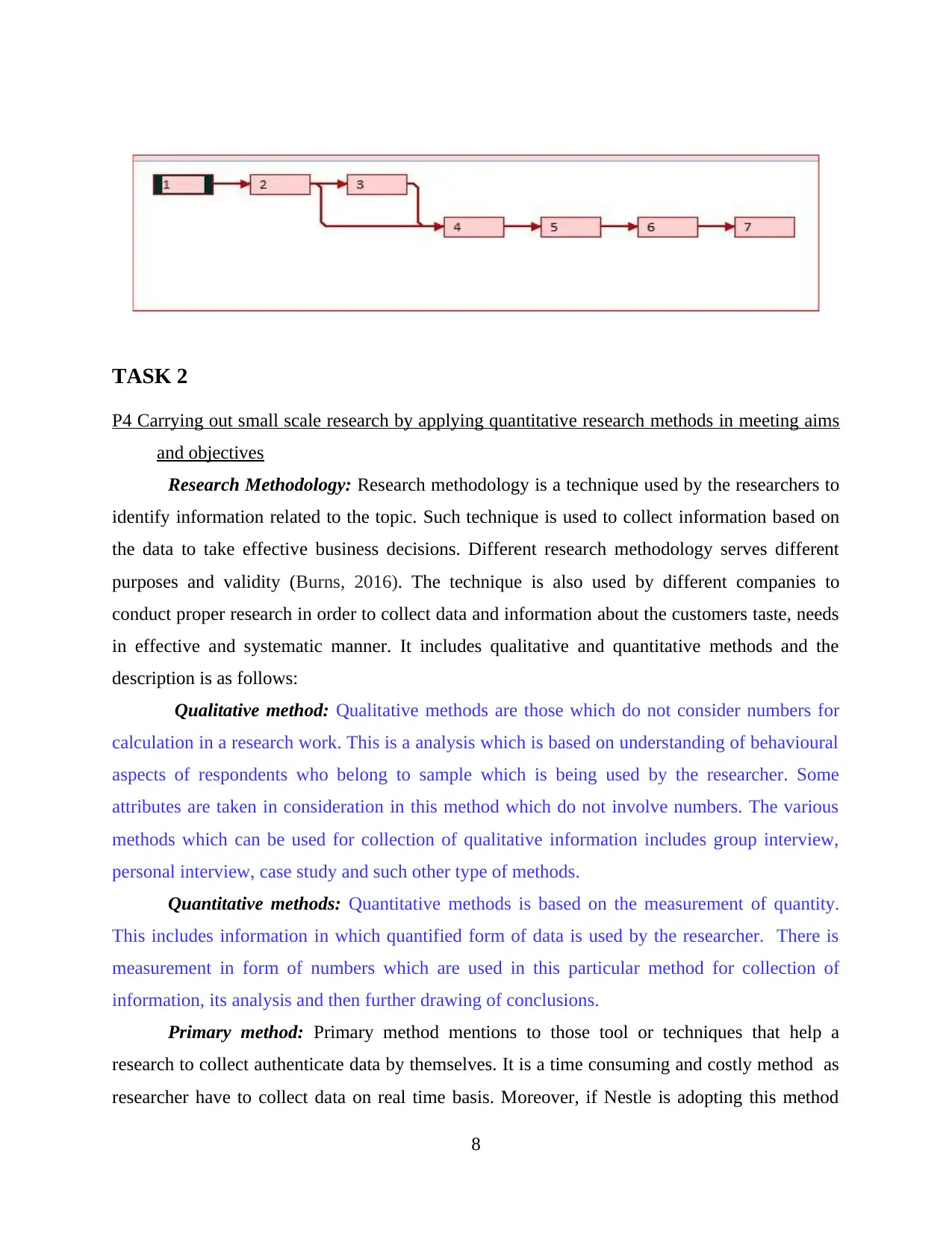
TASK 2
P4 Carrying out small scale research by applying quantitative research methods in meeting aims
and objectives
Research Methodology: Research methodology is a technique used by the researchers to
identify information related to the topic. Such technique is used to collect information based on
the data to take effective business decisions. Different research methodology serves different
purposes and validity (Burns, 2016). The technique is also used by different companies to
conduct proper research in order to collect data and information about the customers taste, needs
in effective and systematic manner. It includes qualitative and quantitative methods and the
description is as follows:
Qualitative method: Qualitative methods are those which do not consider numbers for
calculation in a research work. This is a analysis which is based on understanding of behavioural
aspects of respondents who belong to sample which is being used by the researcher. Some
attributes are taken in consideration in this method which do not involve numbers. The various
methods which can be used for collection of qualitative information includes group interview,
personal interview, case study and such other type of methods.
Quantitative methods: Quantitative methods is based on the measurement of quantity.
This includes information in which quantified form of data is used by the researcher. There is
measurement in form of numbers which are used in this particular method for collection of
information, its analysis and then further drawing of conclusions.
Primary method: Primary method mentions to those tool or techniques that help a
research to collect authenticate data by themselves. It is a time consuming and costly method as
researcher have to collect data on real time basis. Moreover, if Nestle is adopting this method
8
P4 Carrying out small scale research by applying quantitative research methods in meeting aims
and objectives
Research Methodology: Research methodology is a technique used by the researchers to
identify information related to the topic. Such technique is used to collect information based on
the data to take effective business decisions. Different research methodology serves different
purposes and validity (Burns, 2016). The technique is also used by different companies to
conduct proper research in order to collect data and information about the customers taste, needs
in effective and systematic manner. It includes qualitative and quantitative methods and the
description is as follows:
Qualitative method: Qualitative methods are those which do not consider numbers for
calculation in a research work. This is a analysis which is based on understanding of behavioural
aspects of respondents who belong to sample which is being used by the researcher. Some
attributes are taken in consideration in this method which do not involve numbers. The various
methods which can be used for collection of qualitative information includes group interview,
personal interview, case study and such other type of methods.
Quantitative methods: Quantitative methods is based on the measurement of quantity.
This includes information in which quantified form of data is used by the researcher. There is
measurement in form of numbers which are used in this particular method for collection of
information, its analysis and then further drawing of conclusions.
Primary method: Primary method mentions to those tool or techniques that help a
research to collect authenticate data by themselves. It is a time consuming and costly method as
researcher have to collect data on real time basis. Moreover, if Nestle is adopting this method
8
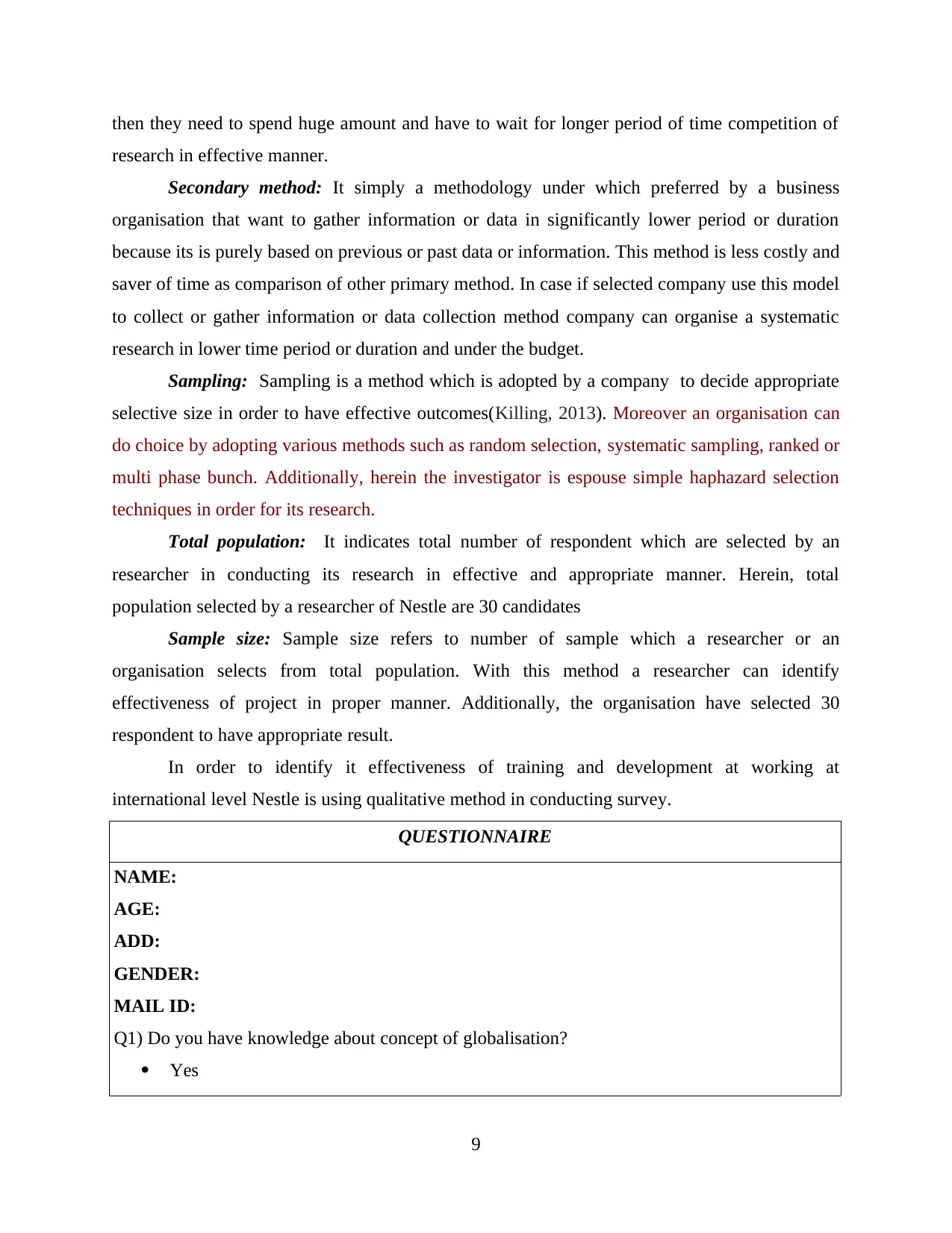
then they need to spend huge amount and have to wait for longer period of time competition of
research in effective manner.
Secondary method: It simply a methodology under which preferred by a business
organisation that want to gather information or data in significantly lower period or duration
because its is purely based on previous or past data or information. This method is less costly and
saver of time as comparison of other primary method. In case if selected company use this model
to collect or gather information or data collection method company can organise a systematic
research in lower time period or duration and under the budget.
Sampling: Sampling is a method which is adopted by a company to decide appropriate
selective size in order to have effective outcomes(Killing, 2013). Moreover an organisation can
do choice by adopting various methods such as random selection, systematic sampling, ranked or
multi phase bunch. Additionally, herein the investigator is espouse simple haphazard selection
techniques in order for its research.
Total population: It indicates total number of respondent which are selected by an
researcher in conducting its research in effective and appropriate manner. Herein, total
population selected by a researcher of Nestle are 30 candidates
Sample size: Sample size refers to number of sample which a researcher or an
organisation selects from total population. With this method a researcher can identify
effectiveness of project in proper manner. Additionally, the organisation have selected 30
respondent to have appropriate result.
In order to identify it effectiveness of training and development at working at
international level Nestle is using qualitative method in conducting survey.
QUESTIONNAIRE
NAME:
AGE:
ADD:
GENDER:
MAIL ID:
Q1) Do you have knowledge about concept of globalisation?
Yes
9
research in effective manner.
Secondary method: It simply a methodology under which preferred by a business
organisation that want to gather information or data in significantly lower period or duration
because its is purely based on previous or past data or information. This method is less costly and
saver of time as comparison of other primary method. In case if selected company use this model
to collect or gather information or data collection method company can organise a systematic
research in lower time period or duration and under the budget.
Sampling: Sampling is a method which is adopted by a company to decide appropriate
selective size in order to have effective outcomes(Killing, 2013). Moreover an organisation can
do choice by adopting various methods such as random selection, systematic sampling, ranked or
multi phase bunch. Additionally, herein the investigator is espouse simple haphazard selection
techniques in order for its research.
Total population: It indicates total number of respondent which are selected by an
researcher in conducting its research in effective and appropriate manner. Herein, total
population selected by a researcher of Nestle are 30 candidates
Sample size: Sample size refers to number of sample which a researcher or an
organisation selects from total population. With this method a researcher can identify
effectiveness of project in proper manner. Additionally, the organisation have selected 30
respondent to have appropriate result.
In order to identify it effectiveness of training and development at working at
international level Nestle is using qualitative method in conducting survey.
QUESTIONNAIRE
NAME:
AGE:
ADD:
GENDER:
MAIL ID:
Q1) Do you have knowledge about concept of globalisation?
Yes
9
⊘ This is a preview!⊘
Do you want full access?
Subscribe today to unlock all pages.

Trusted by 1+ million students worldwide
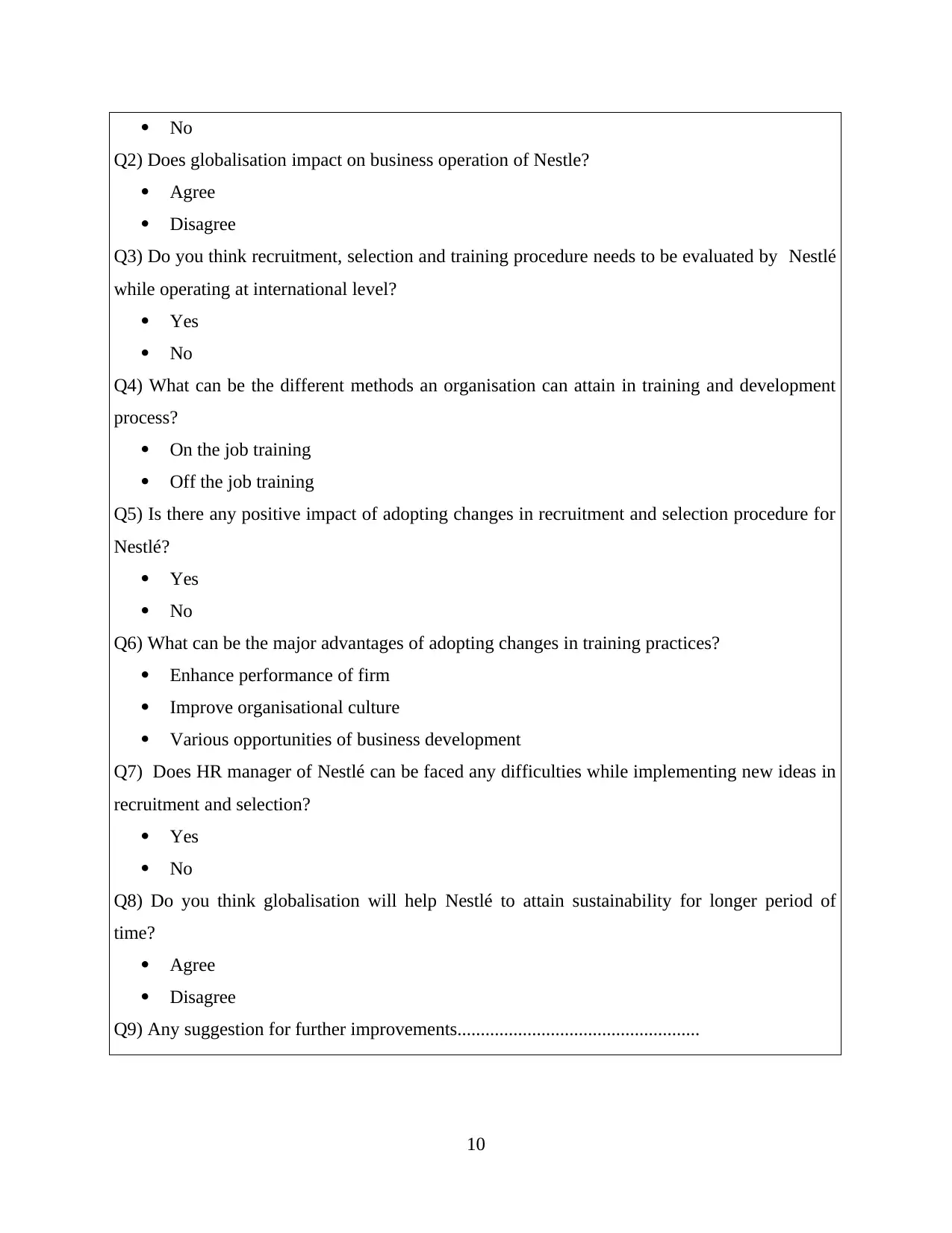
No
Q2) Does globalisation impact on business operation of Nestle?
Agree
Disagree
Q3) Do you think recruitment, selection and training procedure needs to be evaluated by Nestlé
while operating at international level?
Yes
No
Q4) What can be the different methods an organisation can attain in training and development
process?
On the job training
Off the job training
Q5) Is there any positive impact of adopting changes in recruitment and selection procedure for
Nestlé?
Yes
No
Q6) What can be the major advantages of adopting changes in training practices?
Enhance performance of firm
Improve organisational culture
Various opportunities of business development
Q7) Does HR manager of Nestlé can be faced any difficulties while implementing new ideas in
recruitment and selection?
Yes
No
Q8) Do you think globalisation will help Nestlé to attain sustainability for longer period of
time?
Agree
Disagree
Q9) Any suggestion for further improvements....................................................
10
Q2) Does globalisation impact on business operation of Nestle?
Agree
Disagree
Q3) Do you think recruitment, selection and training procedure needs to be evaluated by Nestlé
while operating at international level?
Yes
No
Q4) What can be the different methods an organisation can attain in training and development
process?
On the job training
Off the job training
Q5) Is there any positive impact of adopting changes in recruitment and selection procedure for
Nestlé?
Yes
No
Q6) What can be the major advantages of adopting changes in training practices?
Enhance performance of firm
Improve organisational culture
Various opportunities of business development
Q7) Does HR manager of Nestlé can be faced any difficulties while implementing new ideas in
recruitment and selection?
Yes
No
Q8) Do you think globalisation will help Nestlé to attain sustainability for longer period of
time?
Agree
Disagree
Q9) Any suggestion for further improvements....................................................
10
Paraphrase This Document
Need a fresh take? Get an instant paraphrase of this document with our AI Paraphraser
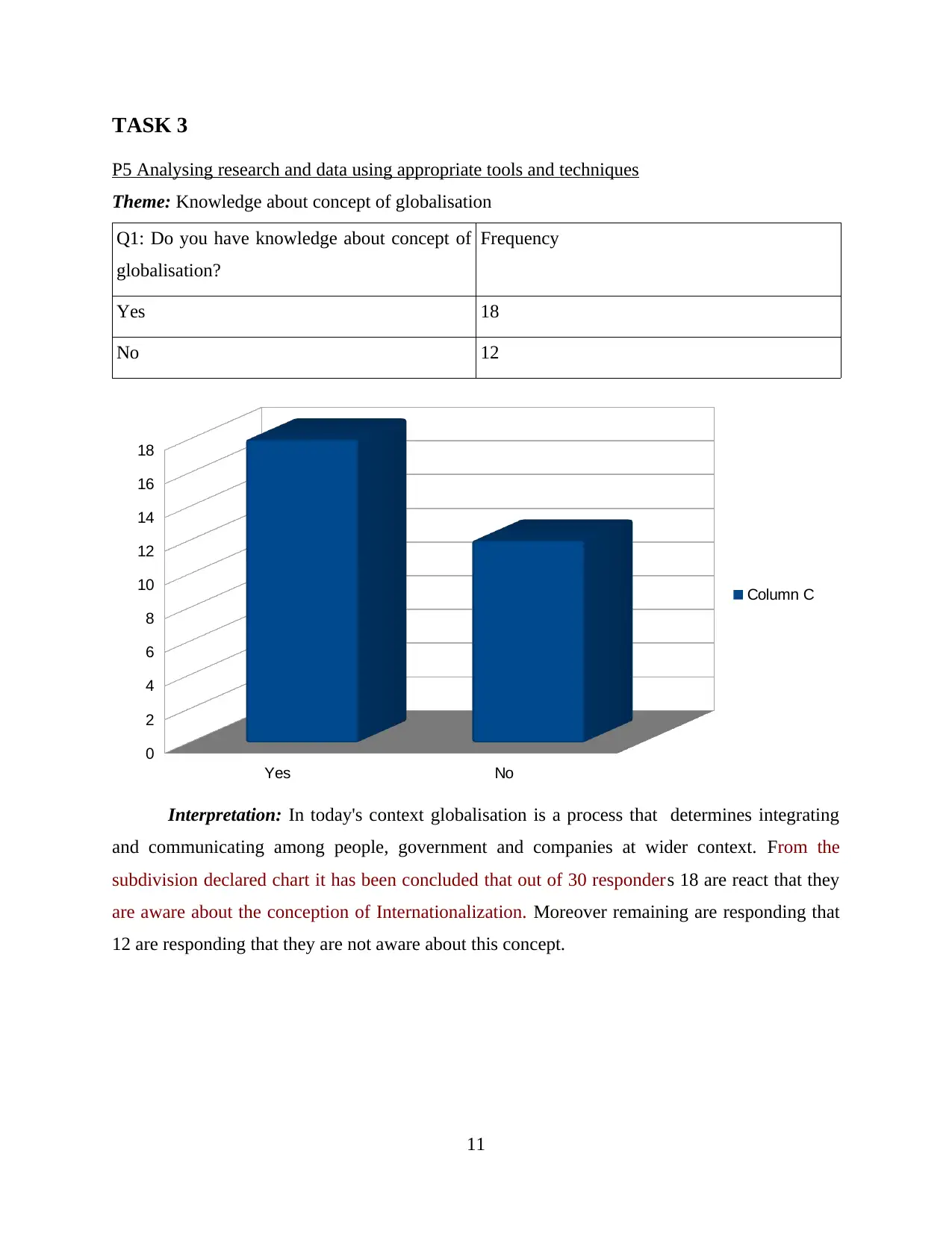
TASK 3
P5 Analysing research and data using appropriate tools and techniques
Theme: Knowledge about concept of globalisation
Q1: Do you have knowledge about concept of
globalisation?
Frequency
Yes 18
No 12
Interpretation: In today's context globalisation is a process that determines integrating
and communicating among people, government and companies at wider context. From the
subdivision declared chart it has been concluded that out of 30 responders 18 are react that they
are aware about the conception of Internationalization. Moreover remaining are responding that
12 are responding that they are not aware about this concept.
11
Yes No
0
2
4
6
8
10
12
14
16
18
Column C
P5 Analysing research and data using appropriate tools and techniques
Theme: Knowledge about concept of globalisation
Q1: Do you have knowledge about concept of
globalisation?
Frequency
Yes 18
No 12
Interpretation: In today's context globalisation is a process that determines integrating
and communicating among people, government and companies at wider context. From the
subdivision declared chart it has been concluded that out of 30 responders 18 are react that they
are aware about the conception of Internationalization. Moreover remaining are responding that
12 are responding that they are not aware about this concept.
11
Yes No
0
2
4
6
8
10
12
14
16
18
Column C
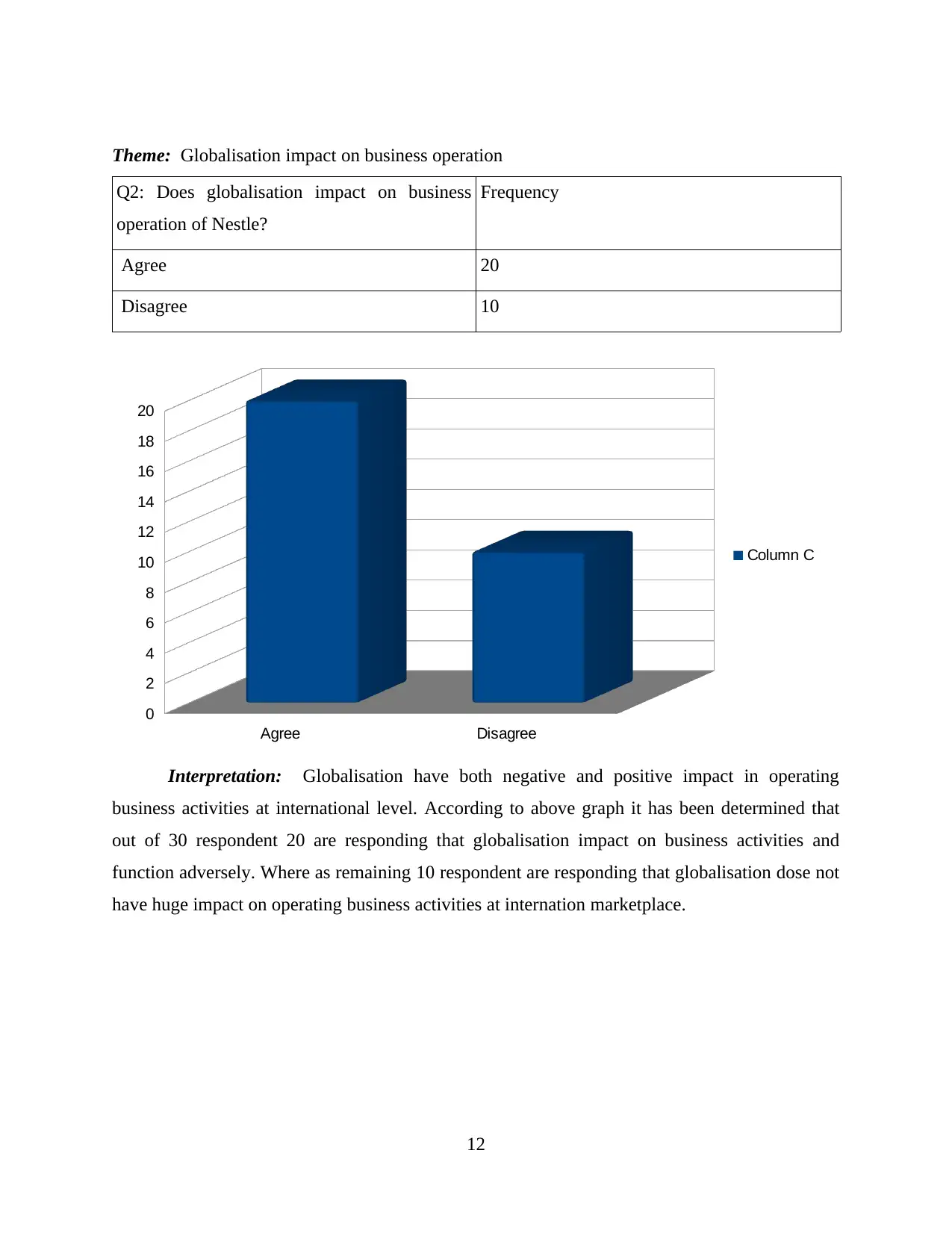
Theme: Globalisation impact on business operation
Q2: Does globalisation impact on business
operation of Nestle?
Frequency
Agree 20
Disagree 10
Interpretation: Globalisation have both negative and positive impact in operating
business activities at international level. According to above graph it has been determined that
out of 30 respondent 20 are responding that globalisation impact on business activities and
function adversely. Where as remaining 10 respondent are responding that globalisation dose not
have huge impact on operating business activities at internation marketplace.
12
Agree Disagree
0
2
4
6
8
10
12
14
16
18
20
Column C
Q2: Does globalisation impact on business
operation of Nestle?
Frequency
Agree 20
Disagree 10
Interpretation: Globalisation have both negative and positive impact in operating
business activities at international level. According to above graph it has been determined that
out of 30 respondent 20 are responding that globalisation impact on business activities and
function adversely. Where as remaining 10 respondent are responding that globalisation dose not
have huge impact on operating business activities at internation marketplace.
12
Agree Disagree
0
2
4
6
8
10
12
14
16
18
20
Column C
⊘ This is a preview!⊘
Do you want full access?
Subscribe today to unlock all pages.

Trusted by 1+ million students worldwide
1 out of 23
Related Documents
Your All-in-One AI-Powered Toolkit for Academic Success.
+13062052269
info@desklib.com
Available 24*7 on WhatsApp / Email
![[object Object]](/_next/static/media/star-bottom.7253800d.svg)
Unlock your academic potential
Copyright © 2020–2025 A2Z Services. All Rights Reserved. Developed and managed by ZUCOL.





